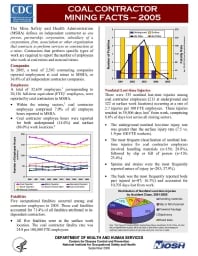Mining Publication: Coal Contractor Mining Facts - 2005
Original creation date: September 2008
Authors: National Institute for Occupational Safety and Health
NIOSHTIC2 Number: 20034777
Pittsburgh, PA: U.S. Department of Health and Human Services, Public Health Service, Centers for Disease Control and Prevention, National Institute for Occupational Safety and Health, DHHS (NIOSH) Publication No. 2008-155, 2008 Sep; :1-2
The Mine Safety and Health Administration (MSHA) defines an independent contractor as any person, partnership, corporation, subsidiary of a corporation, firm, association or other organization that contracts to perform services or construction at a mine. Contractors that perform specific types of work are required to report the number of employees who work at coal mines and noncoal mines.
Companies: In 2005, a total of 2,503 contracting companies reported employment at coal mines to MSHA, or 36.8% of all independent contractor companies. Employees: A total of 32,639 employees, corresponding to 20,136 full-time equivalent (FTE) employees, were reported by coal contractors to MSHA. Within the mining sectors, coal contractor employees comprised 7.0% of all employee hours reported to MSHA. Coal contractor employee hours were reported for both underground (14.0%) and surface (86.0%) work locations.
Fatalities: Five occupational fatalities occurred among coal contractor employees in 2005. These coal fatalities accounted for 71.4% of all fatalities attributed to in-dependent contractors. All five fatalities were at the surface work location. The coal contractor fatality rate was 24.8 per 100,000 FTE employees.
Nonfatal Lost-time Injuries: There were 535 nonfatal lost-time injuries among coal contractor employees (213 at underground and 322 at surface work locations) occurring at a rate of 2.7 injuries per 100 FTE employees. These injuries resulted in 39,506 days lost from work, comprising 8.6% of days lost across all mining sectors. The underground nonfatal lost-time injury rate was greater than the surface injury rate (7.5 vs. 1.9 per 100 FTE workers). The most frequent classification of nonfatal lost-time injuries for coal contractor employees involved handling materials (n=150; 28.0%), followed by slip or fall of person (n=126; 23.6%). Sprains and strains were the most frequently reported nature of injury (n=203; 37.9%). The back was the most frequently reported body part injured (n=87; 16.3%) and accounted for 10,703 days lost from work.

NIOSHTIC2 Number: 20034777
Pittsburgh, PA: U.S. Department of Health and Human Services, Public Health Service, Centers for Disease Control and Prevention, National Institute for Occupational Safety and Health, DHHS (NIOSH) Publication No. 2008-155, 2008 Sep; :1-2
- Coal and metal/nonmetal mining facts - 2008
- Coal and Metal/Nonmetal Mining Facts - 2008 (HTML)
- Coal Contractor Mining Facts - 2001
- Coal Contractor Mining Facts - 2002
- Coal Contractor Mining Facts - 2003
- Coal Contractor Mining Facts - 2004
- Coal Contractor Mining Facts - 2006
- Coal Contractor Mining Facts - 2007
- Mining Fact Sheets
- Rib Falls: A Major Ground Control Issue